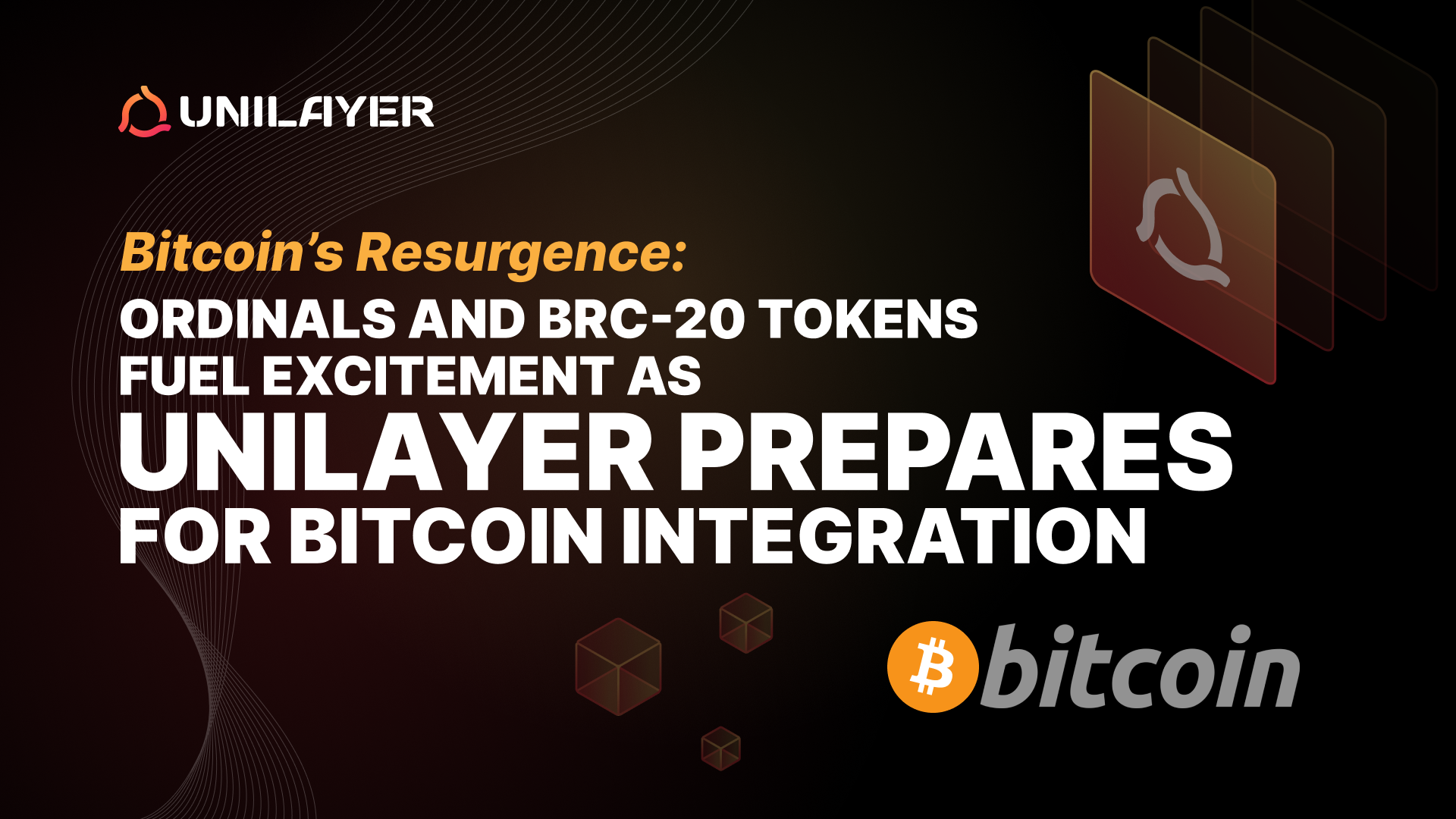Bitcoin’s Resurgence: Ordinals and BRC-20 Tokens Fuel Excitement as UniLayer Prepares for Bitcoin Integration

At the start of 2023, Bitcoin experienced a wave of renewed interest, as banking collapses reignited the narrative of Bitcoin as an alternative store of value and a hedge against inflation, a real alternative to the existing financial system. Over the subsequent months, Bitcoin became the focal point of a number of notable blockchain advances, including the advent of Ordinals, also known as “digital artifacts” or Bitcoin “NFTs”, and the BRC-20 token standard, which expanded Bitcoin’s utility to encompass non-fungible and fungible tokens.
Ordinals and BRC-20 tokens have quickly gained significant traction. By mid-May, the total market cap of all BRC-20 tokens had surpassed $1 billion, while Bitcoin Ordinals have continued to dominate top NFT collection sales. Increased network activity has resulted in higher transaction fees, a burden for some users, but a boon for the long-lasting strength, security, and sustainability of the Bitcoin network as a whole.
While the long-term implications of these developments are still unknown (as these technologies are continuously evolving), one thing is for certain: Bitcoin’s utility, flexibility, and scale are set to increase drastically over time.
UniLayer and Bitcoin
UniLayer has chosen Bitcoin as its first network to integrate with, as Bitcoin remains the unchallenged top blockchain of the entire crypto ecosystem, and is now undergoing a new wave of innovation and growth. It is inevitable that Bitcoin will play a major role in the future of interoperability, as much for its unparalleled decentralization and security as for its widespread adoption and deep liquidity. Integration will begin on UniLayer’s testnet, which is live and currently undergoing a series of significant updates.
To participate in UniLayer’s testnet, please apply here.
UniLayer’s Bitcoin integration is anticipated to be a landmark advance for interoperability. It also follows on the heels of UniLayer’s MetaMask integration, a first of its kind, as MetaMask had only supported Ethereum and ERC-20 tokens, up to this point. The MetaMask integration is a key component of UniLayer’s roadmap, which lays out a path to mass adoption through on-chain interoperability.
Bitcoin integration is the next step.
However, before diving deeper into UniLayer’s broader vision and plans, let’s take a step back to look at Bitcoin’s current evolution, examining how it fits within the context of interoperability as a whole.
Colored Coins: an Early Exploration of Bitcoin’s Potential
To crypto newcomers, the recent appearance of Ordinals and BRC-20 tokens may be their initial exposure to changes within the Bitcoin ecosystem. However, the history of Bitcoin is replete with attempts to expand the network’s utility, versatility, and accessibility.
In 2012, just 3 years after the mining of the Bitcoin Genesis Block, developer Yoni Assia conceived of the idea of “colored coins”. He theorized that a “satoshi” (the smallest division of a Bitcoin - one 100 millionth) could be augmented with attached metadata, converting a tiny, individual fraction of a coin into a unique digital asset: this was the precursor to the NFT. Colored coins, Assia wrote, could be programmed to represent real-world assets, independent digital currencies, or collectibles.
It wasn’t long before developers began releasing protocols to support and facilitate the colored coin system, most notably, Counterparty. Counterparty allowed participants to create colored coins for a myriad of uses, from DApps and ICOs to digital collectibles and games. It also had ambitions to support a DEX, art marketplace, and multiple blockchain games.
However, despite the utility and flexibility of the colored coin system, it was unable to gain traction over the long term. Bitcoin’s inherent design limitations, namely the size restrictions of unspent transaction outputs (UTXOs), made colored coins unfeasible for many applications. To add to this challenge, a number of core Bitcoin developers did not approve of new, alternative use cases for the Bitcoin network. Soon, other blockchain networks - most notably Ethereum - were created with the express purpose of supporting smart contracts, new tokens, and NFTs. Developers and users quickly migrated to Ethereum and other layer-1 chains, drawn to their utility, ease of use, adaptability, and scalability.
Bitcoin Re-imagined: Ordinals and the BRC-20 Token Standard
Over the past few years, several changes to Bitcoin’s architecture have set the stage for exciting, new developments around the network. The SegWit and Taproot updates increased Bitcoin’s block size (from 1MB to 4MBs), as well as its speed and efficiency, respectively. These changes were essential for the conception and development of Ordinals.
Ordinals: Bitcoin-native NFTs
Ordinals, also called “digital artifacts”, are satoshis that have been linearly ordered (hence the name), and therefore possess unique individual identities. Ordinals can be “inscribed” with separate information (arbitrary data), in the form of text, audio, or video. One inventive user even inscribed a satoshi with the code of the vintage video game, Doom, ensuring its perpetual existence on chain.
Significantly, Ordinals do not rely on a sidechain or separate token; they exist completely on chain, in contrast to NFTs on Ethereum or other networks, which typically store metadata (or pointers to art or other content) off chain. Ordinals are the most secure, immutable form of “NFTs” on any blockchain, due to Bitcoin’s massively decentralized network and stable architecture.
Ordinals and UniLayer
UniLayer is a layer-1 interoperable platform, and as such, allows NFTs to be sent to or from any integrated network. Once UniLayer's network integrations are online, Ordinals will gain multichain capabilities: transferable to other networks via the UniLayer network (while remaining completely on chain during the entire process). Significantly, UniLayer preserves the full history of any NFT it interacts with, a valuable feature for DApps developers, NFT holders and traders.
BRC-20s: the Bitcoin Network’s (Fungible) Tokens
BRC-20 is Bitcoin’s answer to Ethereum’s ERC-20 token standard. Ethereum's token standard has played a major role in the broad scope and utility of the Ethereum network, as it has allowed for the creation of new smart contract tokens, compatible with the Ethereum network.
While BRC-20 tokens cannot yet support complex smart contracts (in contrast to the Ethereum network), Bitcoin's fungible token standard already represents the first step toward real, versatile utility - not least of all, Bitcoin-native DeFi. Though meme coin trends have dominated much of the initial trading volume of BRC-20s, it should hardly come as a surprise that this new development is beginning with a period of experimentation. Regardless of present use cases, the demand is clearly there, as the BRC-20 market cap reached a high of $1.5 billion in May of 2023.
BRC-20s and UniLayer
Like Ordinals, BRC-20 tokens stand to gain enormously from UniLayer's Bitcoin integration. First, the integration will provide Bitcoin's security and stability to any layer-0, layer-1, or layer-2 that is connected to the UniLayer network. It will also increase liquidity and trading opportunities, and promises to increase the versatility and use cases of BRC-20 tokens, as UniLayer's smart contracts are able to direct smart contracts across multiple networks, tapping into the unique strengths of each.
The Future is Cross-Chain
UniLayer's layer-1 network is an interoperable platform, designed to power a new generation of cross-chain DApps. Recent developments with the Bitcoin network serve to only strengthen the UniLayer team's conviction that Bitcoin will play a key role in the broader, cross-chain crypto ecosystem.
As UniLayer finishes updating the testnet to fully support the groundbreaking MetaMask integration, UniLayer will soon be ready to take on an indispensable role within the blockchain space.
UniLayer's vision and mission is to connect all major blockchains on chain, to unite a splintered crypto ecosystem, maintaining each chain’s autonomy, while allowing all to enjoy the full benefits of universal interoperability.
To learn more about UniLayer and where we’re headed, visit UniLayer.io.
To stay up to date on our MetaMask and Bitcoin integrations, and more, follow us on Twitter.
To join our growing community and talk to the team directly, visit our official Discord.

